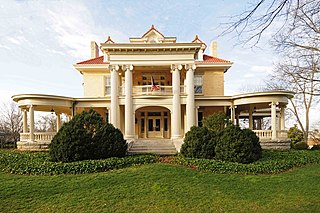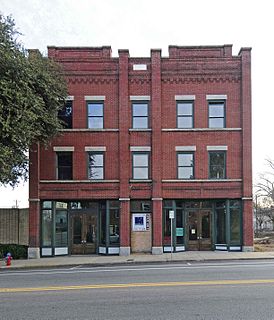Magnolia, now known as Wavering Place also previously known as the Francis Tucker Hopkins House, is a historic plantation house located near Gadsden, Richland County, South Carolina. It was built about 1855, and is a two-story, Greek Revival style frame building with a full stuccoed brick basement and weatherboard siding. The front facade features a portico with columns rest on tall stuccoed pedestals. Also on the property are a brick kitchen/office, a frame smokehouse and two one-story frame slave houses.

Marsh-Johnson House, also known as Robert Johnson House, is a historic home located near Saluda, Saluda County, South Carolina. It was built about 1817, and is a two-story, log farmhouse sheathed in weatherboard. The house sits on a brick foundation and has a one-story, shed-roofed porch. It is considered one of the earliest and intact log residences in South Carolina. The house rests on massive brick piers, which are laid in Flemish bond. A one-story, shed-roofed porch with wooden foundation piers and four rough hewn tree trunks supporting the roof spans the façade. Many of the windows retain their batten shutters.

Caldwell–Hampton–Boylston House is a historic home located at Columbia, South Carolina. It was built between 1820 and 1830, and is a three-story, five bay, clapboard clad frame dwelling in the Greek Revival style. It features a two-story, projecting front porch. Also on the property is contributing ironwork and brick fencing, and a stable/carriage house, garden gazebo, and tea house. In 1874–1876, it was the residence of South Carolina Reconstruction governor Daniel H. Chamberlain, who purchased the house in 1869.

Debruhl-Marshall House is a historic home located in Columbia, South Carolina. It was built in 1820, and is a two-story, five bay, brick Greek Revival style dwelling. It has a gabled slate roof and full basement. The front facade features a three bay portico supported by four massive Doric order columns.

Taylor House, also known as the former home of the Columbia Museum of Art, is a historic home located at Columbia, South Carolina. It was designed by the architectural firm of Andrews, Jacques and Rantoul and built in 1908, as a two-story, "L"-shaped, brick Neo-Classical style mansion. The front facade features a projecting portico supported by large, fluted limestone Corinthian order columns. It was built for Thomas Taylor, Jr., who served as president of Taylor Manufacturing Company.

Mountain Shoals Plantation, also known as the James Nesbitt House, is a historic plantation house located at Enoree, Spartanburg County, South Carolina. It was built by 1837, and is a two-story, vernacular Federal style frame residence. It sits on a raised brick basement stuccoed to resemble granite and features a full-width, one-story, front porch. Also located on the property is a contributing well house and a one-story log cabin.

Walter Scott Montgomery House is a historic home located at Spartanburg, Spartanburg County, South Carolina. It was designed by architect George Franklin Barber and built in 1909. It is a 2+1⁄2-story, frame, yellow brick-veneer residence in the Colonial Revival style. building is of frame construction with a yellow brick veneer and a red tile roof. It features a distinctive portico and leaded glass windows. Also on the property is a one-story, reinforced concrete auto garage.

Hotel Oregon, also known as Oakman Drugs, Oakman Glass, and Spartan Hotel, is a historic hotel building located at Spartanburg, Spartanburg County, South Carolina. It was built in 1909, and is a three-story, brick building with two first floor storefronts. It features horizontal granite belt courses, decorative brick panels, brick cornices, and a stepped front parapet.

Carnegie Public Library is a historic Carnegie library building located at Sumter, Sumter County, South Carolina. It was built in 1916–1917, and is a two-story, brick Beaux-Arts style building. The front facade features four arched windows with limestone surrounds and the main entryway flanked by two Ionic order columns. It was one of the 1,679 public libraries built in the United States with funding from the Carnegie Corporation. The Sumter library was constructed with $10,000 provided by the Carnegie Corporation. It housed the public library until 1968, and afterwards housed a local genealogical society.

Culp House is a historic home located at Union, Union County, South Carolina. It was built about 1857, and is a two-story, brick structure, with Georgian and Neo-Classical design details. The front façade features a two-tiered, five-bay porch with Doric order columns.

Scott House, also known as the Scott-Hauenstein House, is a historic home located at Kingstree, Williamsburg County, South Carolina. It was built about 1843, and is a two-story, three bay, frame building, sheathed in weatherboard, with a side-gabled roof and brick foundation. The front façade features a "Carolina" or "rain porch." Its builder was Joseph Scott, a wealthy planter, trustee of the Kingstree Academy, and politician. It is the oldest on-site house in Kingstree.

Thorntree, also known as the Witherspoon House, is a historic plantation house located at Kingstree, Williamsburg County, South Carolina. It was built in 1749 by immigrant James Witherspoon (1700-1765), and is a two-story, five-bay, frame "I-house" dwelling with a hall and parlor plan and exterior end chimneys. It features full-length piazzas on the front and rear elevations. To preserve it, the house was moved from an inaccessible rural site to Kingstree on land donated as a memorial park, known as Fluitt-Nelson Memorial Park. The house has been restored to its 18th-century appearance and is open to the public by appointment with the Williamsburg Historical Society.
New Market, also known as the McDonald-Rhodus-Lesesne House, is a historic home and national historic district located near Greeleyville, Williamsburg County, South Carolina. It encompasses 2 contributing buildings and 2 contributing sites. The house was built about 1820, and a one-story, frame extended Double Pen house over a raised brick basement. It features a typical "rain porch" on the front of the house supported by four tapered and chamfered wooden posts. Also on the property are a 1 1/2-story frame tobacco pack house, the foundation of a greenhouse, and a pecan avenue and grove.

Wilson House, also known as Old Jail and Yorkville Jail, is a historic home located at York, York County, South Carolina. It is attributed to Robert Mills and was built in 1828. It is a three-story, brick building originally designed as a local jail. It features brick arches and a semi-circular fanlight. It was converted into a residence in 1853, then used as a jail during the Reconstruction Era when Federal troops imprisoned Ku Klux Klan members.

Mack-Belk House is a historic home located at Fort Mill, York County, South Carolina. It consists of a one-story rear section built in the 1860s, with a two-story, three bay, brick main block built about 1890. It features a one-story, hip roofed wraparound porch with Late Victorian design elements.

Thornwell-Elliott House is a historic home located at Fort Mill, York County, South Carolina. It was built about 1877, and is a one-story, "L"-shaped frame dwelling in the Late Victorian style. The front façade features hip roofed porch with decorative brackets and turned balustrade.

Wilson House, also known as the Hull House, is a historic home located at Fort Mill, York County, South Carolina. It was built about 1869, and is a two-story, three bay, frame I-house with several one-story rear additions. The front façade features hip roofed porch with decorative brackets and turned balustrade in the Late Victorian style.

John M. White House, also known as Springs Industries Guest House, is a historic home located at Fort Mill, York County, South Carolina. It was built about 1872, and is a two-story brick dwelling with Italianate and Second Empire style design elements. It features a low-pitched, bracketed roof, a front verandah with decorative brackets, and a mansard roofed central pavilion. Also on the property is a one-story brick cottage and carriage house / garage.

William Elliott White House -- also known as Elliott White Springs House—is a historic home located near Fort Mill, York County, South Carolina. It was built in 1831, and is a two-story brick house with Federal design elements. It features an elegant portico. The east wing was added in 1922, the west wing in 1936, and the greenhouse/pool in 1955. The house is one of the sites believed to have held the last full meeting of the Cabinet of the Confederate States of America. It was the home of Elliott White Springs, South Carolina textile magnate and writer of short stories in the 1920s and 1930s.

Hightower Hall is a historic home located near McConnells, York County, South Carolina. Completed in 1856, Hightower Hall is a two-story, weatherboarded frame dwelling in a vernacular interpretation of the Italianate style. The front facade features a prominent three-story tower that rises ten feet above the main roof of the house. It also has a low-pitched roof, deep eaves, decorative brackets and verandahs. Also on the property are two barns and two slave cabins.






















